-
 Bitcoin
Bitcoin $105,045.4964
-2.69% -
 Ethereum
Ethereum $2,523.1428
-8.12% -
 Tether USDt
Tether USDt $1.0003
0.04% -
 XRP
XRP $2.1322
-4.95% -
 BNB
BNB $651.1269
-2.04% -
 Solana
Solana $145.0960
-8.59% -
 USDC
USDC $0.9999
0.02% -
 Dogecoin
Dogecoin $0.1769
-6.05% -
 TRON
TRON $0.2698
-1.70% -
 Cardano
Cardano $0.6324
-7.16% -
 Hyperliquid
Hyperliquid $40.5644
-5.20% -
 Sui
Sui $3.0163
-9.61% -
 Chainlink
Chainlink $13.1373
-8.80% -
 Bitcoin Cash
Bitcoin Cash $430.4956
-1.86% -
 UNUS SED LEO
UNUS SED LEO $9.0436
1.90% -
 Stellar
Stellar $0.2580
-5.85% -
 Avalanche
Avalanche $19.0739
-9.24% -
 Toncoin
Toncoin $2.9809
-6.53% -
 Shiba Inu
Shiba Inu $0.0...01191
-5.48% -
 Hedera
Hedera $0.1554
-7.47% -
 Litecoin
Litecoin $84.2778
-5.46% -
 Polkadot
Polkadot $3.8124
-6.03% -
 Ethena USDe
Ethena USDe $1.0004
0.00% -
 Monero
Monero $312.2453
-3.04% -
 Dai
Dai $0.9998
0.00% -
 Bitget Token
Bitget Token $4.5182
-4.00% -
 Uniswap
Uniswap $7.3870
-6.27% -
 Pepe
Pepe $0.0...01076
-11.47% -
 Aave
Aave $279.4127
-7.67% -
 Pi
Pi $0.5645
-9.30%
Three consecutive negatives with reduced volume to stop the decline: Is the rebound about to begin?
The "three consecutive negatives with reduced volume" pattern in crypto can signal a potential rebound, but traders should use additional indicators for confirmation.
Jun 11, 2025 at 04:49 pm
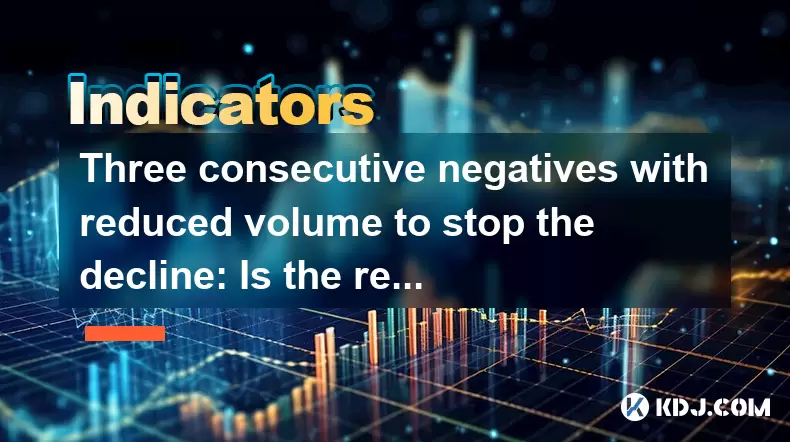
In the volatile world of cryptocurrencies, understanding market trends and patterns is crucial for making informed investment decisions. One pattern that traders often look for is the "three consecutive negatives with reduced volume". This pattern can signal that a downtrend might be losing momentum, potentially leading to a rebound. In this article, we will explore this pattern in detail, examining its significance and what it could mean for the market.
Understanding the Three Consecutive Negatives Pattern
The "three consecutive negatives with reduced volume" pattern refers to a situation where a cryptocurrency experiences three successive days of price declines, but with each day showing a lower trading volume than the previous one. This pattern suggests that the selling pressure is decreasing, which could indicate that the market is running out of sellers and a reversal might be imminent.
Volume is a key indicator in this pattern. When the volume decreases alongside price declines, it often means that fewer traders are willing to sell at lower prices, which can be a sign that the bearish momentum is waning. Conversely, if the volume were to increase during these declines, it would suggest strong selling pressure and a continuation of the downtrend.
Historical Examples of the Pattern
To better understand the "three consecutive negatives with reduced volume" pattern, let's look at some historical examples within the cryptocurrency market. One notable instance occurred with Bitcoin in early 2020. After a period of significant price drops, Bitcoin exhibited three consecutive days of negative returns with decreasing volume. Following this pattern, Bitcoin began a notable rebound, climbing from around $6,000 to over $10,000 in a matter of weeks.
Another example can be found with Ethereum in late 2018. After a prolonged bear market, Ethereum showed three days of consecutive declines with diminishing volume. This was followed by a recovery phase that saw Ethereum's price increase by nearly 30% in the subsequent month.
Analyzing the Current Market Context
When assessing whether the "three consecutive negatives with reduced volume" pattern signals an upcoming rebound, it's essential to consider the broader market context. Factors such as overall market sentiment, macroeconomic conditions, and regulatory news can influence whether the pattern leads to a sustained recovery or just a temporary bounce.
For instance, if the pattern occurs during a period of high market fear or uncertainty, the rebound might be short-lived. On the other hand, if the pattern coincides with positive developments such as favorable regulatory news or increased institutional adoption, the chances of a more significant recovery increase.
Technical Indicators to Confirm the Pattern
To increase the confidence in the "three consecutive negatives with reduced volume" pattern as a signal for a potential rebound, traders often use additional technical indicators. Some of the most commonly used indicators include:
- Relative Strength Index (RSI): If the RSI is oversold (typically below 30), it can indicate that the asset is due for a rebound.
- Moving Averages: A bullish crossover, where a shorter-term moving average crosses above a longer-term moving average, can confirm a potential reversal.
- MACD (Moving Average Convergence Divergence): A bullish MACD crossover can signal that momentum is shifting in favor of a rebound.
By combining these indicators with the "three consecutive negatives with reduced volume" pattern, traders can make more informed decisions about entering or exiting positions.
Potential Risks and Considerations
While the "three consecutive negatives with reduced volume" pattern can be a useful tool for identifying potential rebounds, it's important to be aware of the risks and limitations. Not every instance of this pattern will lead to a sustained recovery. False signals can occur, leading to potential losses if traders enter positions based solely on this pattern.
Moreover, the cryptocurrency market is known for its high volatility and unpredictability. External factors such as sudden regulatory changes, security breaches, or macroeconomic shifts can quickly alter market dynamics, overriding the signals provided by technical patterns.
Strategies for Trading the Pattern
For traders looking to capitalize on the "three consecutive negatives with reduced volume" pattern, here are some strategies to consider:
- Wait for Confirmation: Instead of entering a position immediately after the pattern, wait for additional confirmation from other technical indicators. This can help reduce the risk of false signals.
- Use Stop-Loss Orders: To manage risk, always set stop-loss orders to limit potential losses if the market moves against your position.
- Monitor Volume: Keep a close eye on trading volume after entering a position. A significant increase in volume following the pattern can confirm the strength of the rebound.
- Diversify: Avoid putting all your capital into a single trade based on this pattern. Diversify your investments to spread risk across different assets and strategies.
By following these strategies, traders can better navigate the complexities of the cryptocurrency market and potentially benefit from the "three consecutive negatives with reduced volume" pattern.
Frequently Asked Questions
Q: Can the "three consecutive negatives with reduced volume" pattern be applied to all cryptocurrencies?
A: While the pattern can be observed in various cryptocurrencies, its effectiveness may vary depending on the liquidity and market dynamics of each specific asset. More liquid cryptocurrencies like Bitcoin and Ethereum tend to exhibit clearer patterns, making the signal more reliable.
Q: How long should traders wait for confirmation after observing the pattern?
A: The duration can vary, but many traders wait for at least one to two days to see if additional technical indicators confirm the potential rebound. It's crucial to balance the need for confirmation with the risk of missing out on a rapid price movement.
Q: Are there other patterns that can complement the "three consecutive negatives with reduced volume" pattern?
A: Yes, other patterns such as the "double bottom" or "bullish engulfing" can provide additional confirmation of a potential reversal. Combining multiple patterns and indicators can enhance the reliability of trading signals.
Q: How does market sentiment affect the effectiveness of this pattern?
A: Market sentiment plays a significant role in the effectiveness of the "three consecutive negatives with reduced volume" pattern. Positive sentiment can amplify the impact of the pattern, leading to stronger rebounds, while negative sentiment can dampen the effect and result in weaker or short-lived recoveries.
Disclaimer:info@kdj.com
The information provided is not trading advice. kdj.com does not assume any responsibility for any investments made based on the information provided in this article. Cryptocurrencies are highly volatile and it is highly recommended that you invest with caution after thorough research!
If you believe that the content used on this website infringes your copyright, please contact us immediately (info@kdj.com) and we will delete it promptly.
- Ethereum (ETH) ETF Inflows Hit 4-Month Highs, BlackRock's iShares Ethereum Trust (ETHA) Dominates
- 2025-06-14 02:40:12
- Bitcoin Price (BTC Price) Fell Down to USD 1,08,000 Today
- 2025-06-14 02:40:12
- SB Bank Has Entered Its Pre-Launch Phase
- 2025-06-14 02:35:13
- Pistachio, the Newly Launched Mobile-First Onchain Deobank, Integrates with Plume Mainnet
- 2025-06-14 02:35:13
- Circle Internet Group's stock surged 10.7% on Wednesday after it announced two major deals
- 2025-06-14 02:35:13
- Wednesday's Softer-than-Expected U.S. Inflation Has Likely Set the Stage for Accelerated Gains in Bitcoin
- 2025-06-14 02:35:13
Related knowledge
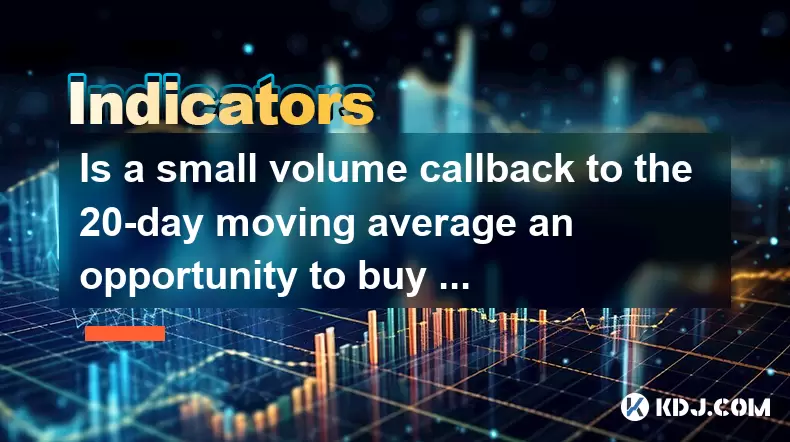
Is a small volume callback to the 20-day moving average an opportunity to buy low? What is the key to look at?
Jun 14,2025 at 02:28am
Understanding the 20-Day Moving Average in Cryptocurrency TradingIn cryptocurrency trading, the 20-day moving average (20DMA) is a commonly used technical indicator that helps traders assess the short-term trend of an asset. It calculates the average price of a cryptocurrency over the last 20 days and smooths out price volatility. When a coin experience...
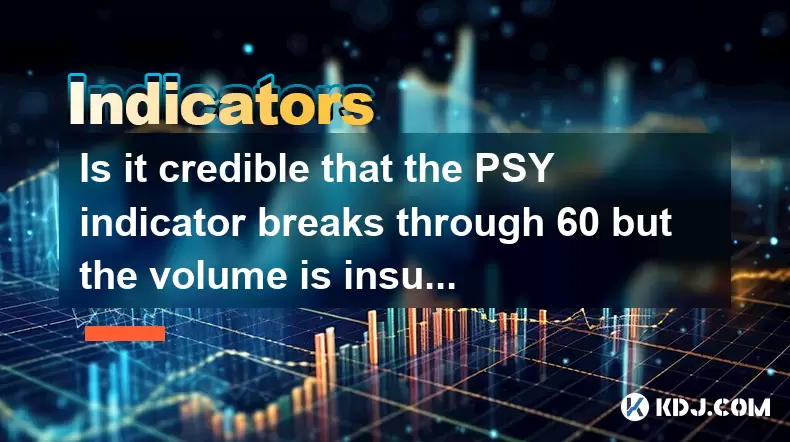
Is it credible that the PSY indicator breaks through 60 but the volume is insufficient?
Jun 14,2025 at 12:14am
Understanding the PSY Indicator in Cryptocurrency TradingThe Psychological Line (PSY) indicator is a momentum oscillator used primarily to measure the sentiment of traders and investors in financial markets, including the cryptocurrency space. It calculates the ratio of days where prices closed higher versus lower over a specified period, typically 12 o...
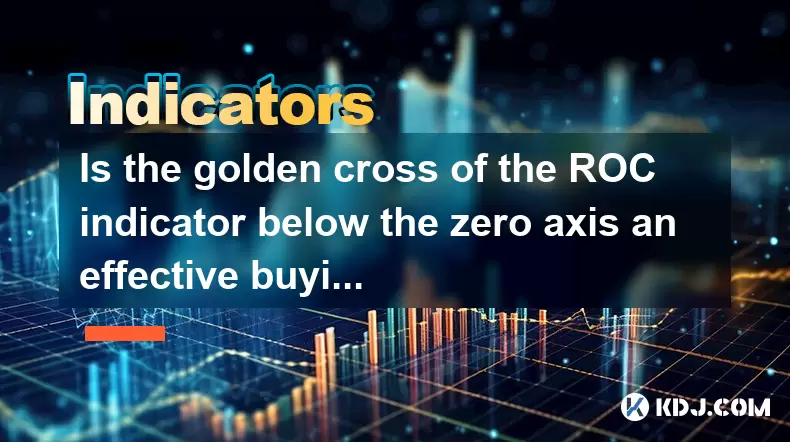
Is the golden cross of the ROC indicator below the zero axis an effective buying point?
Jun 14,2025 at 01:29am
Understanding the ROC Indicator and Its SignificanceThe Rate of Change (ROC) indicator is a momentum oscillator used in technical analysis to measure the percentage change in price between the current closing price and the closing price from a set number of periods ago. This tool helps traders assess the speed at which prices are changing, offering insi...

Will the RSI fall after the top divergence? How to improve the judgment accuracy?
Jun 13,2025 at 11:21pm
Understanding RSI and Top Divergence in Cryptocurrency TradingThe Relative Strength Index (RSI) is a momentum oscillator widely used in cryptocurrency trading to measure the speed and change of price movements. It typically ranges from 0 to 100, with levels above 70 considered overbought and below 30 considered oversold. In crypto markets, where volatil...
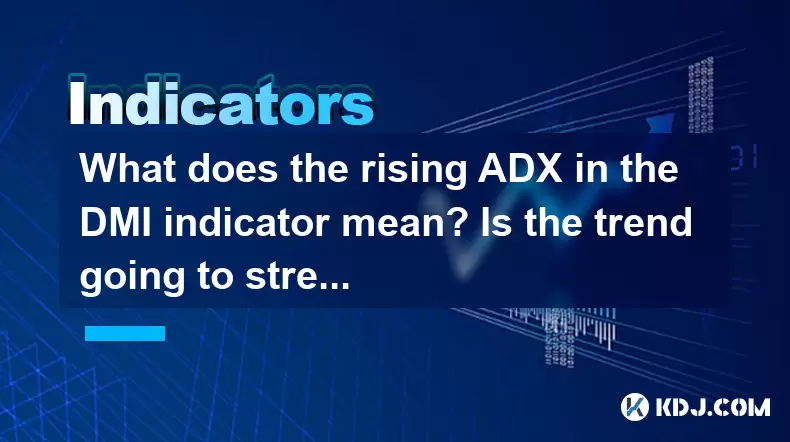
What does the rising ADX in the DMI indicator mean? Is the trend going to strengthen?
Jun 14,2025 at 02:14am
Understanding the DMI Indicator and ADXThe Directional Movement Index (DMI) is a technical analysis tool used to identify the direction and strength of a trend. It consists of two lines: the Positive Directional Indicator (+DI) and the Negative Directional Indicator (-DI). Alongside these, the ADX line measures the strength of the trend, regardless of i...
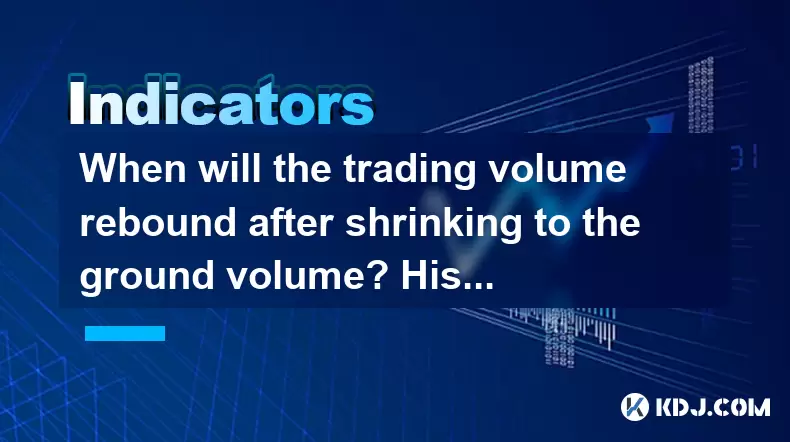
When will the trading volume rebound after shrinking to the ground volume? Historical percentile comparison method
Jun 13,2025 at 03:36pm
Understanding the Ground Volume Concept in Cryptocurrency MarketsIn cryptocurrency trading, 'ground volume' refers to a period when the trading volume of a particular asset or market drops significantly, often reaching multi-month or even multi-year lows. This phenomenon typically signals a lack of interest from traders and investors, suggesting that th...

Is a small volume callback to the 20-day moving average an opportunity to buy low? What is the key to look at?
Jun 14,2025 at 02:28am
Understanding the 20-Day Moving Average in Cryptocurrency TradingIn cryptocurrency trading, the 20-day moving average (20DMA) is a commonly used technical indicator that helps traders assess the short-term trend of an asset. It calculates the average price of a cryptocurrency over the last 20 days and smooths out price volatility. When a coin experience...

Is it credible that the PSY indicator breaks through 60 but the volume is insufficient?
Jun 14,2025 at 12:14am
Understanding the PSY Indicator in Cryptocurrency TradingThe Psychological Line (PSY) indicator is a momentum oscillator used primarily to measure the sentiment of traders and investors in financial markets, including the cryptocurrency space. It calculates the ratio of days where prices closed higher versus lower over a specified period, typically 12 o...

Is the golden cross of the ROC indicator below the zero axis an effective buying point?
Jun 14,2025 at 01:29am
Understanding the ROC Indicator and Its SignificanceThe Rate of Change (ROC) indicator is a momentum oscillator used in technical analysis to measure the percentage change in price between the current closing price and the closing price from a set number of periods ago. This tool helps traders assess the speed at which prices are changing, offering insi...

Will the RSI fall after the top divergence? How to improve the judgment accuracy?
Jun 13,2025 at 11:21pm
Understanding RSI and Top Divergence in Cryptocurrency TradingThe Relative Strength Index (RSI) is a momentum oscillator widely used in cryptocurrency trading to measure the speed and change of price movements. It typically ranges from 0 to 100, with levels above 70 considered overbought and below 30 considered oversold. In crypto markets, where volatil...

What does the rising ADX in the DMI indicator mean? Is the trend going to strengthen?
Jun 14,2025 at 02:14am
Understanding the DMI Indicator and ADXThe Directional Movement Index (DMI) is a technical analysis tool used to identify the direction and strength of a trend. It consists of two lines: the Positive Directional Indicator (+DI) and the Negative Directional Indicator (-DI). Alongside these, the ADX line measures the strength of the trend, regardless of i...

When will the trading volume rebound after shrinking to the ground volume? Historical percentile comparison method
Jun 13,2025 at 03:36pm
Understanding the Ground Volume Concept in Cryptocurrency MarketsIn cryptocurrency trading, 'ground volume' refers to a period when the trading volume of a particular asset or market drops significantly, often reaching multi-month or even multi-year lows. This phenomenon typically signals a lack of interest from traders and investors, suggesting that th...
See all articles

























































































